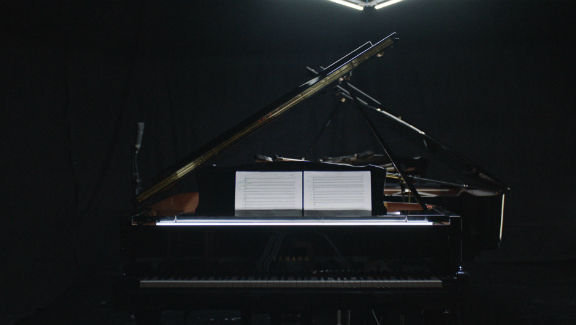Infinity minus Infinity
Synopsis
INFINITY MINUS INFINITY brings together dance, music, recital and digital animation to compose a transhistorical zone in which the unpayable debts of racial capitalism cannot be separated from the ongoing crimes of capitalogenic climate catastrophe. Infinity minus Infinity enacts the durational timelines of past distress, present duress and future dread through the assembly of a chorus of trans-temporal deities whose utterances, expressions, gestures and movements personify the compounded, accumulated, irreparable times and spaces of the hostile environment.
The phrase ‘hostile environment’ invokes the covert policy of targeting migrants enacted by the Conservative government since 2014. It stands for the criminalisation of the Afro-Caribbean women and men that migrated to Britain in the 1950s to help reconstruct its industrial infrastructure. The effort to detain and deport these women and men of the Windrush generation – so called because they followed in the wake of the men that emigrated to Britain from the Caribbean on board the SS Empire Windrush in 1948 – reveals the British state’s commitment to disarticulating the forms of attachment and belonging of Afro-Caribbean settlement that helped decolonize the British empire from within.
Infinity minus Infinity extends the policy of the ongoing hostile environment backward and forward in an inter-scalar movement between times and spaces that dramatises Saidiya V. Hartman’s formulation of the afterlife of slavery within a choreography of what Christina Sharpe calls anti-blackness as total climate. (RCA)
Official Selection Berlin International Film Festival 2020 - Forum Expanded - International premiere
Details
- Year
- 2020
- Type of project
- Shorts
- Running time
- 52 min
- Director
-
The Otolith Group
- Commissioned For
- Sharjah Architecture Triennial
Categories
Production Status
Production Company
UK, United Arab Emirates, Belgium co-production
Page updates
This page was last updated on 12th May 2025. Please let us know if we need to make any amendments or request edit access by clicking below.
See also
You may also be interested in other relevant projects in the database.
 The Third Part of the Third Measure
The Third Part of the Third Measure
Director: The Otolith Group
Year: 2018
'The Third Part of the Third Measure' creates an encounter with the militant minimalism of avant-garde composer, pianist and vocalist Julius Eastman. The two-channel video installation focuses on what The Otolith Group (Anjalika Sagar and Kodwo Eshun) describe as an “experience of watching in the key of listening”, invoking political feelings of defiance and the collective practice of movement building that participates in the global struggles against neoreactionary authoritarianism. Their work invites viewers to attend to exemplary ecstatic aesthetics of black radicalism that Eastman himself once described as “full of honor, integrity and boundless courage”. (Berlinale brochure) Official Selection Berlinale 2018 - Forum Expanded Exhibition - "A Mechanism Capable of Changing Itself" - Group exhibition at Akademie der Künste, Hanseatenweg
 Elegy for the Lost
Elegy for the Lost
Director: William Hong-xiao Wei
Year: 2025
Through the psychoanalytic and introspective voiceover of a young post-pandemic Chinese migrant in Europe, the film interweaves her private memories of intimacy with public narratives of resistance. As her reflections unfold, she and her community navigate secrecy, repression, survival, looming precarity, and displacement, all while confronting the personal cost of existing in a world that demands their silence.
 How to Be a Ghost in Bangkok?
How to Be a Ghost in Bangkok?
Director: Jing Zhao
Year: 2025
After being ghosted by a romantic partner during a trip to Bangkok, the artist situates a contemporary act within a timeless Southeast Asian ghost cultural gesture, transforming personal heartbreak into a surreal exploration of ghosthood while reimagining its embodiment through ten playful yet haunting guidelines. Shifting between satire and introspection, the film contemplates the fragility of relationships and the futility and opacity of communication in the hyper-connected digital age.

